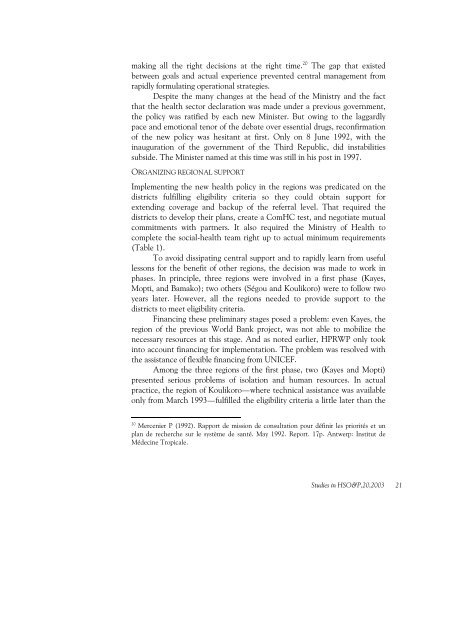Health sector reform in Mali, 1989-1996 - TropMed Central Antwerp ...
Health sector reform in Mali, 1989-1996 - TropMed Central Antwerp ...
Health sector reform in Mali, 1989-1996 - TropMed Central Antwerp ...
Create successful ePaper yourself
Turn your PDF publications into a flip-book with our unique Google optimized e-Paper software.
mak<strong>in</strong>g all the right decisions at the right time. 20 The gap that existed<br />
between goals and actual experience prevented central management from<br />
rapidly formulat<strong>in</strong>g operational strategies.<br />
Despite the many changes at the head of the M<strong>in</strong>istry and the fact<br />
that the health <strong>sector</strong> declaration was made under a previous government,<br />
the policy was ratified by each new M<strong>in</strong>ister. But ow<strong>in</strong>g to the laggardly<br />
pace and emotional tenor of the debate over essential drugs, reconfirmation<br />
of the new policy was hesitant at first. Only on 8 June 1992, with the<br />
<strong>in</strong>auguration of the government of the Third Republic, did <strong>in</strong>stabilities<br />
subside. The M<strong>in</strong>ister named at this time was still <strong>in</strong> his post <strong>in</strong> 1997.<br />
ORGANIZING REGIONAL SUPPORT<br />
Implement<strong>in</strong>g the new health policy <strong>in</strong> the regions was predicated on the<br />
districts fulfill<strong>in</strong>g eligibility criteria so they could obta<strong>in</strong> support for<br />
extend<strong>in</strong>g coverage and backup of the referral level. That required the<br />
districts to develop their plans, create a ComHC test, and negotiate mutual<br />
commitments with partners. It also required the M<strong>in</strong>istry of <strong>Health</strong> to<br />
complete the social-health team right up to actual m<strong>in</strong>imum requirements<br />
(Table 1).<br />
To avoid dissipat<strong>in</strong>g central support and to rapidly learn from useful<br />
lessons for the benefit of other regions, the decision was made to work <strong>in</strong><br />
phases. In pr<strong>in</strong>ciple, three regions were <strong>in</strong>volved <strong>in</strong> a first phase (Kayes,<br />
Mopti, and Bamako); two others (Ségou and Koulikoro) were to follow two<br />
years later. However, all the regions needed to provide support to the<br />
districts to meet eligibility criteria.<br />
F<strong>in</strong>anc<strong>in</strong>g these prelim<strong>in</strong>ary stages posed a problem: even Kayes, the<br />
region of the previous World Bank project, was not able to mobilize the<br />
necessary resources at this stage. And as noted earlier, HPRWP only took<br />
<strong>in</strong>to account f<strong>in</strong>anc<strong>in</strong>g for implementation. The problem was resolved with<br />
the assistance of flexible f<strong>in</strong>anc<strong>in</strong>g from UNICEF.<br />
Among the three regions of the first phase, two (Kayes and Mopti)<br />
presented serious problems of isolation and human resources. In actual<br />
practice, the region of Koulikoro—where technical assistance was available<br />
only from March 1993—fulfilled the eligibility criteria a little later than the<br />
20 Mercenier P (1992). Rapport de mission de consultation pour déf<strong>in</strong>ir les priorités et un<br />
plan de recherche sur le système de santé. May 1992. Report. 17p. <strong>Antwerp</strong>: Institut de<br />
Médec<strong>in</strong>e Tropicale.<br />
Studies <strong>in</strong> HSO&P,20,2003 21











